Seljalandsfoss and Gljúfrabúi – Unique Waterfalls with Caves, Iceland
Of all the waterfalls you’ll see while in Iceland, Seljalandsfoss and Gljúfrabúi are likely the first ones you’ll visit. With most people visiting south Iceland and doing the ring road counterclockwise, Seljalandsfoss and Gljúfrabúi are the first two major waterfalls you’ll find along the way, and a definitive must-see.
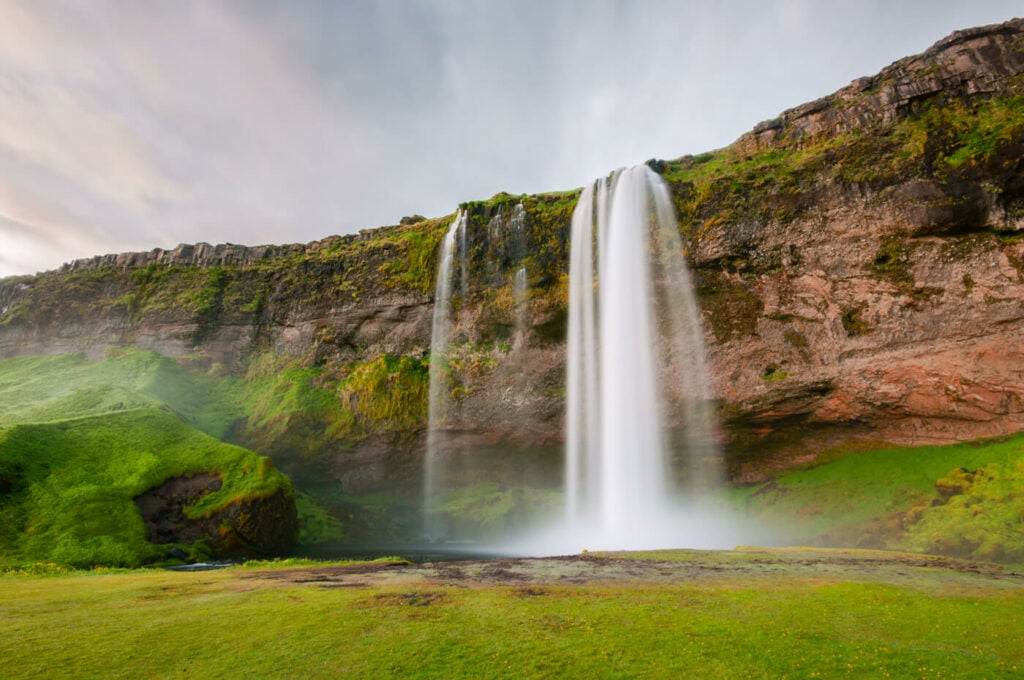
Seljalandsfoss, about 11 pm in June 2012
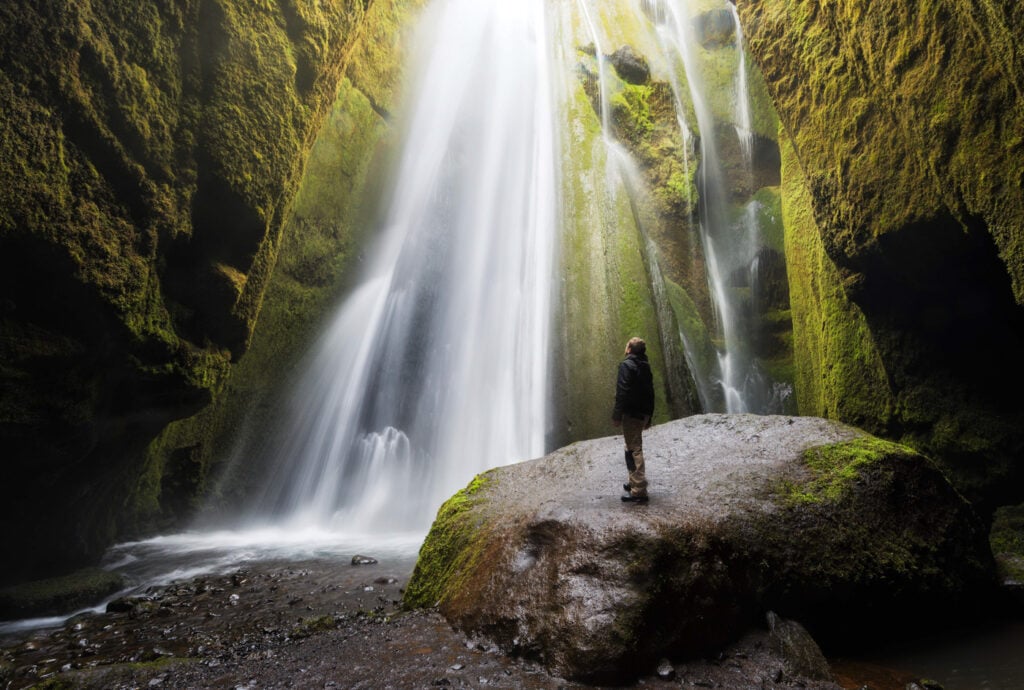
Gljufrabui (or Gljúfrafoss), selfie.
You can already see Seljalandsfoss (60m) from afar when driving toward the south coast. Gljúfrabúi, also (40m), instead, is that hidden waterfall near Seljalandsfoss and you can’t see it at all.
Also, while Seljalandsfoss is a waterfall you can walk behind, Gljúfrabúi is one of those rare waterfalls you need to walk…inside! Not exactly through the curtain of water, but you do have to enter a cave through a very narrow and wet passage.
In a way, Gljúfrabúi is a bit of a “secret” waterfall. As it is entirely hidden from the outside and is only accessible via a very narrow passage. It is easy to miss if you don’t know it’s there, but it provides a rather unique experience.
That’s also the reason why I have combined both in one post, as you should not miss Gljúfrabúi if you are visiting Seljalandsfoss.
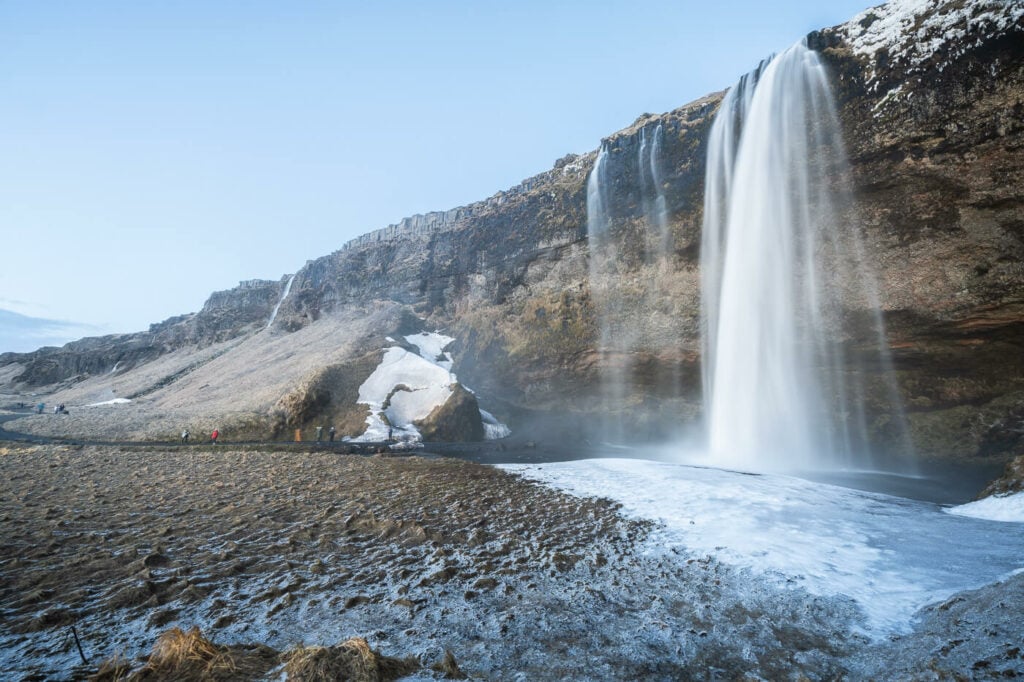
Seljalandsfoss in winter
Table of Contents
Overview if the Seljalandsfoss and Gljúfrabúi Hike
This is a short walk, doable all year round. The only limitation will be walking around and behind Seljalandsfoss; the path behind the waterfall will be closed in winter. This is not only to prevent people from slipping on an icy path; the main danger comes from big icicles and blocks of ice falling from the top of the waterfall.
Apart from that, it’s an easy walk. While the out-and-back trail is only just a little over 2km long, it’s easy to spend an hour here just looking around, this stop may take longer than you’d imagine. It did for me, each time I visited.
| Max Altitude | 40 m |
|---|---|
| Distance | 2.20KM |
| Elevation gain | 20 m ↑ / 20 m ↓ |
| Hike time | 00:40/ 01:00 Hours |
| Hike Difficulty | Easy |
Here is also the map of this short hike:
How to get to Seljalandsfoss and Gljúfrabúi
This is easily reachable as it is located directly along the ring road and as mentioned earlier, you can see Seljalandsfoss from afar.
- Driving Directions: From Reykjavik, it takes a little less than two hours to reach Seljalandfoss. If you are coming from the opposite direction, Vik, It takes a little less than one hour. From either direction, You will have to turn onto urn onto road 249 þórsmerkurvegur and you approach Seljalandsfoss, and from there follow the signs.
- Parking: Paid parking is available right by the waterfall. In 2024, Parking at Seljalandsfoss costs 900ISK and it’s valid for 24 hours. Tip! you can park free of charge a little further away from the waterfall. That is the old Seljalandsfoss parking and info board. You can walk to the waterfall from there in less than 10 minutes.
- Public Transport: it’s possible to get to Seljalandsfoss by bus. The IcelandByBus schedule that starts on Jun 10 heading to Thorsmork, stops at Seljalandsfoss for 30 minutes.
If you are looking for car rental options, I can recommend Blue Car Rental (with a 5% discount through ThePhotoHikes, read more about it here!).
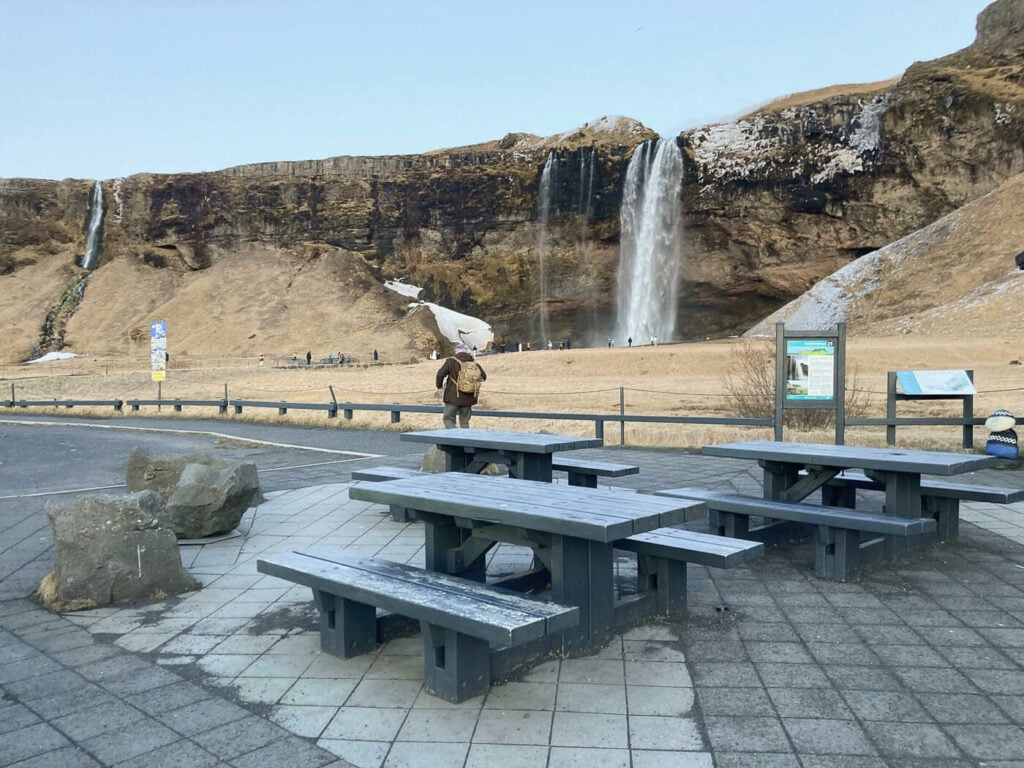
There are a few tables suitable for a picnic right next to the waterfall, as well as a gift shot and some small huts where you can purchase food or snacks.
The Seljalandsfoss and Gljúfrabúi Trail
This is an easy walk, but you should be careful when walking behind Seljalandsfoss and into Gljufrabui. Both are very wet and slippery. Apart from that, it’s an easy walk between the two.
The walk behind Seljalandsfoss is a very wet one, and slippery. You can walk all around the waterfall, 360 degrees, and circle back to the main trail. You don’t actually have to walk behind if you don’t want you, there is also a bridge across the river.
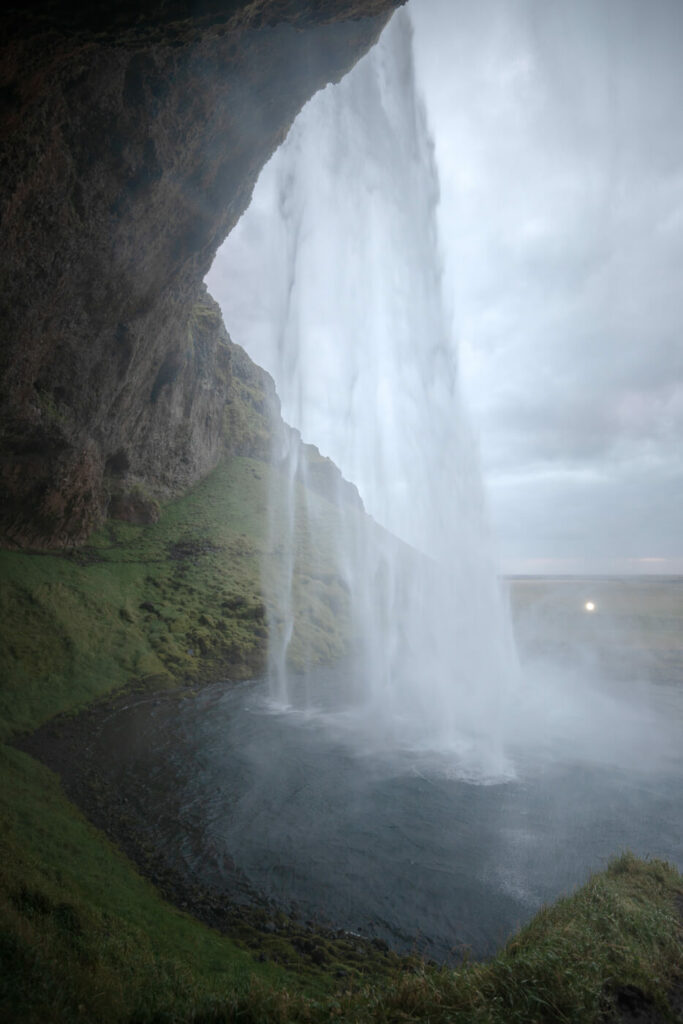
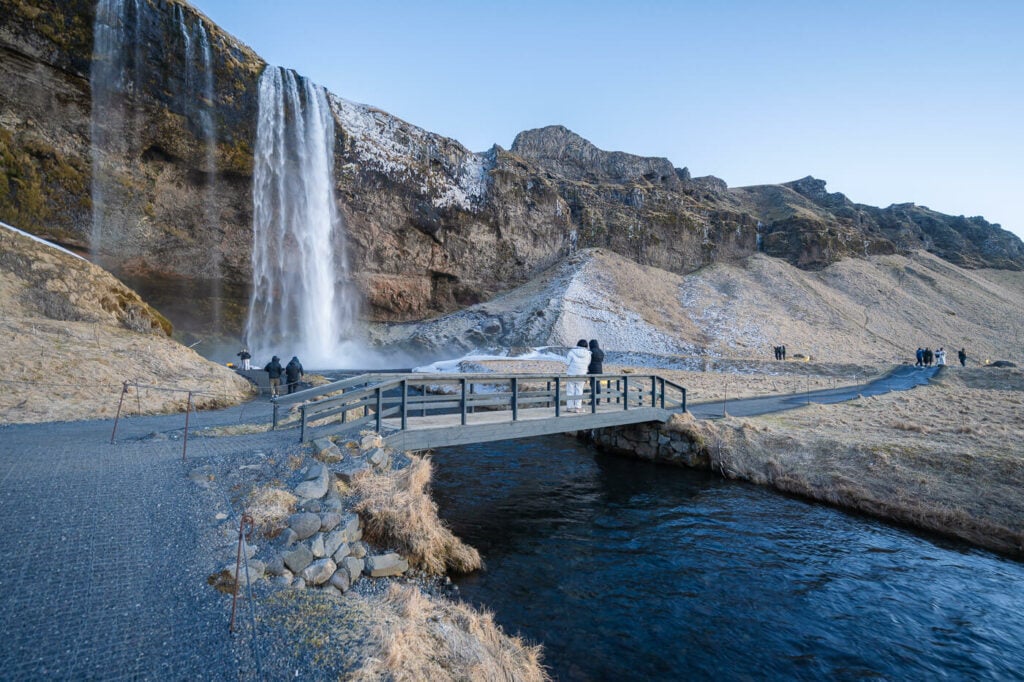
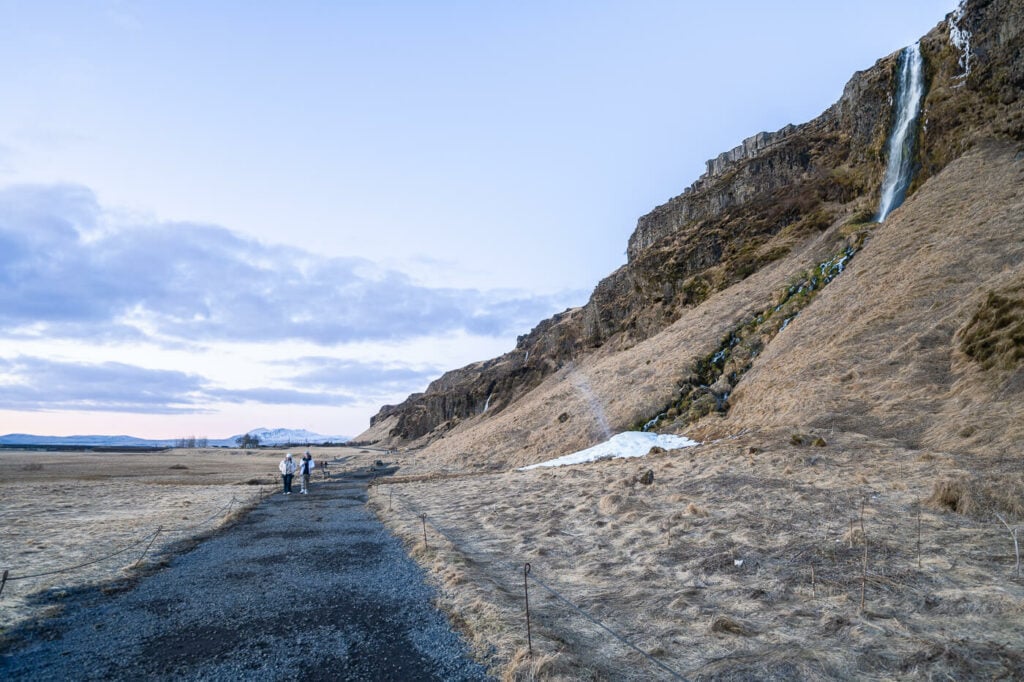
The path connecting Seljalandsfoss and Gljufrabui
Once you are back on the main trail, it’s a 10-15-minute walk to Gljúfrabúi and Gljúfrafoss. The gravel path is wide and flat, so it’s an easy walk. The tricky part is entering Gljúfrabúi. Depending on water levels, you may be able to hop on stones that emerge from the small creek, without getting wet feet.
It may also be not doable without waterproof shoes if water levels are higher. In most cases though, it should be possible to enter the face.
Literally, it rains in there! It is advisable to have a waterproof jacket or a raincoat with a hood when entering the Gljufrabui cave.
Anyway, this is the m most “adventurous” part of the walk and a unique experience that only Iceland can offer. Within ten meters, it’s like going from one of the most touristic locations in Iceland to a secluded location where you’d expect to see Elves or Trolls.
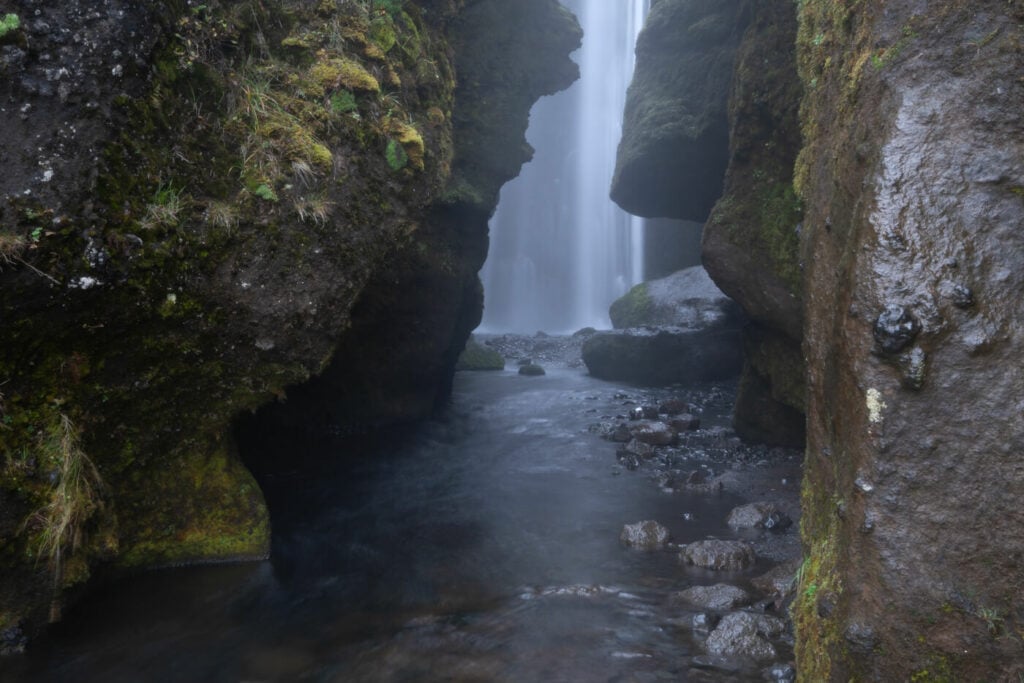
Entrance of Gljufrabui
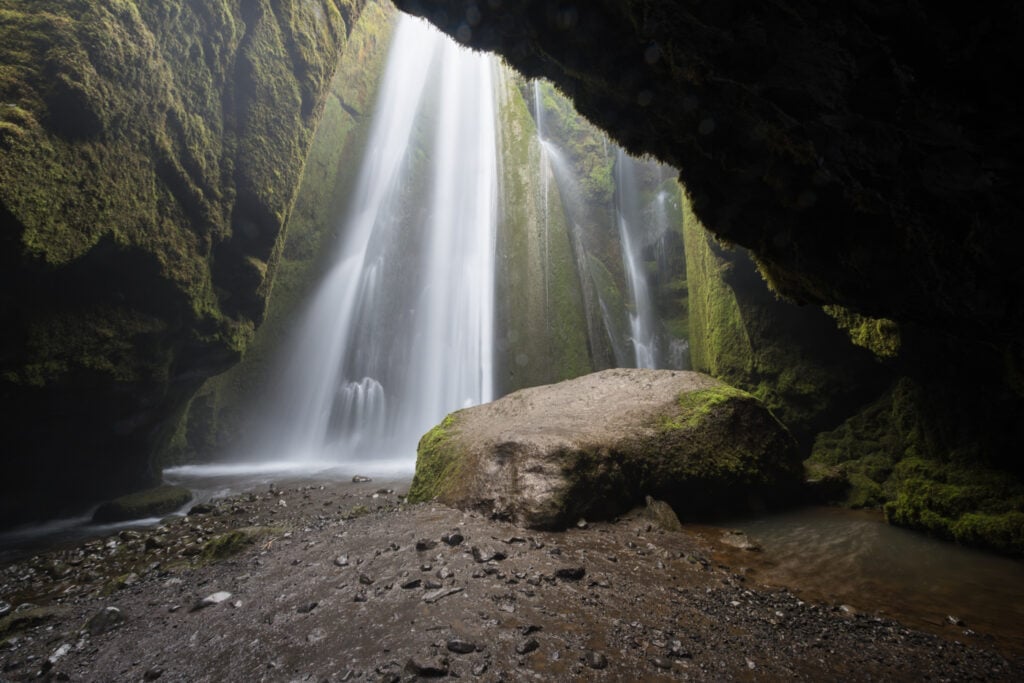
The Cave is a very wet place, embrace it :)!
Seljalandsfoss and Gljúfrabúi Photos and Photography Tips
Obviously, Seljalandsfoss is one of the most popular locations on the south coast of Iceland, both in terms of tourism and landscape photography.
So my first tip would be don’t let the crowds and popularity of this location deter you from stopping here and taking some photos. This is a fun location to take pictures at. After all, it’s all about seeing beautiful places and having fun taking pictures, if you take them.

There will likely be someone around the waterfall at any time, but evenings are usually better both in terms of crowds and light.
If you want to avoid the crowd, try to visit from late May to July, very late in the evening. At that time of the year, the sun sets very late and the light is good because the waterfall faces the south. And there will be few people around, if any.
Anyway, the waterfall faces west so it is a great sunset location, especially if you plan to catch the sun setting from the cave and across the waterfall. The best times of the year to catch the sunset at Seljalandsfoss is around the end of May and the end of August until mid-September. In between the sun sets too far north, but even at that time of the year, the light will be great during the afternoon golden hour.
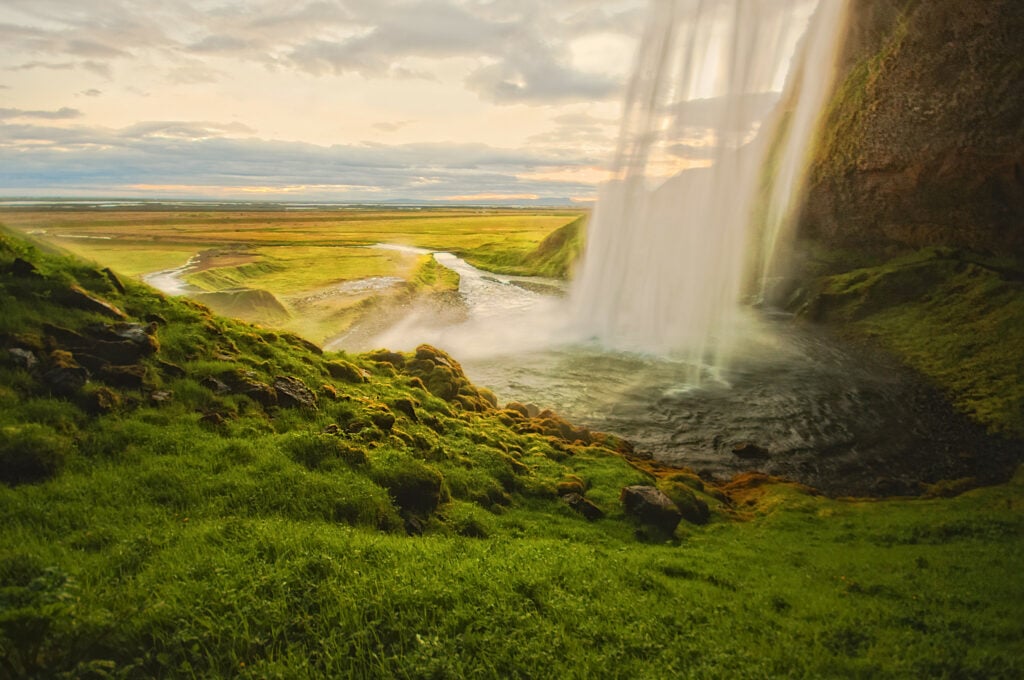
Sunset at Seljalandsfoss, in Late June. The sun already sets out of sight to the right at that time of the year
When shooting in the cave, you’ll likely need to do a panorama to capture it all. The cave is huge and even a 14mm lens on full frame isn’t wide enough to capture it all. If you have a lens such as an 11mm full frame it’s better, although I don’t have one so I can’t tell for sure.
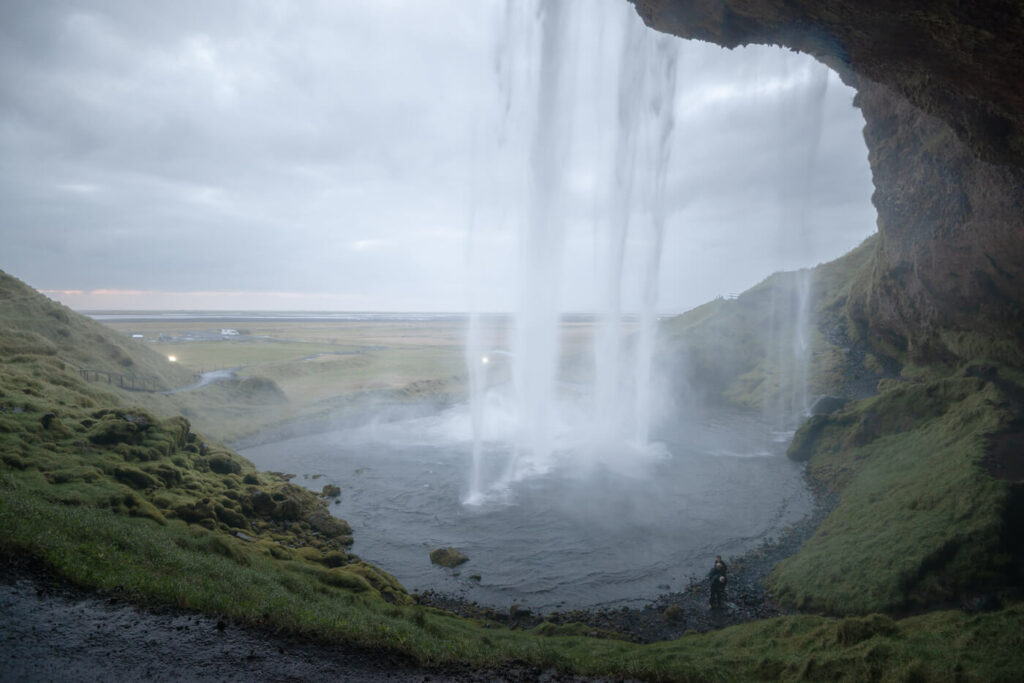
Example of a phot taken at 14mm, the cave barely fits in the frame.
Do bring a microfiber cloth, there’s a lot of water spray and the front element or filter will get a lot of water in between compositions. Also because you’ll need it even more at
Now onto Gljufrabui; This is a hard location to shoot. As mentioned earlier is like being in a shower, so your camera and lens will take a lot of spray too.
I’d recommend keeping it covered when entering the cave, so your gear doesn’t get unnecessarily wet. Or, if you have it, use one of those plastic covers you can find for cheap in online stores, or even in a plastic bag keeping just the front element out.
You should know this, especially if you want to take a photo of someone on the rock. Just pull the camera out when you are ready to shoot. If you, like me, are a solo shooter, good luck running back and forth…and spot-healing every little dry of water on the lens :)

Lastly, Seljalandsfoss is also a good place to catch the northern lights. While I’m no fan of floodlight, the one at Seljalandsfoss works well in terms of landscape photography.
I was lucky enough to see them during my last trip to Iceland when the lights made a short appearance and allowed me to see the amazing, natural light show.
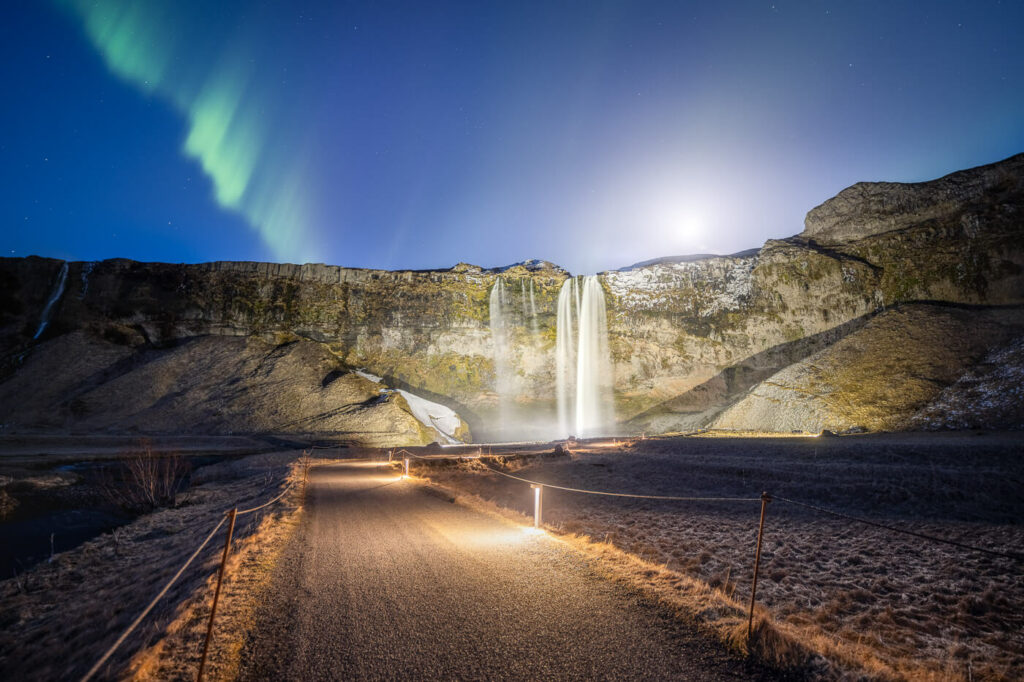
Northern Lights, Moonlight and Floodlights at Seljalandsfoss
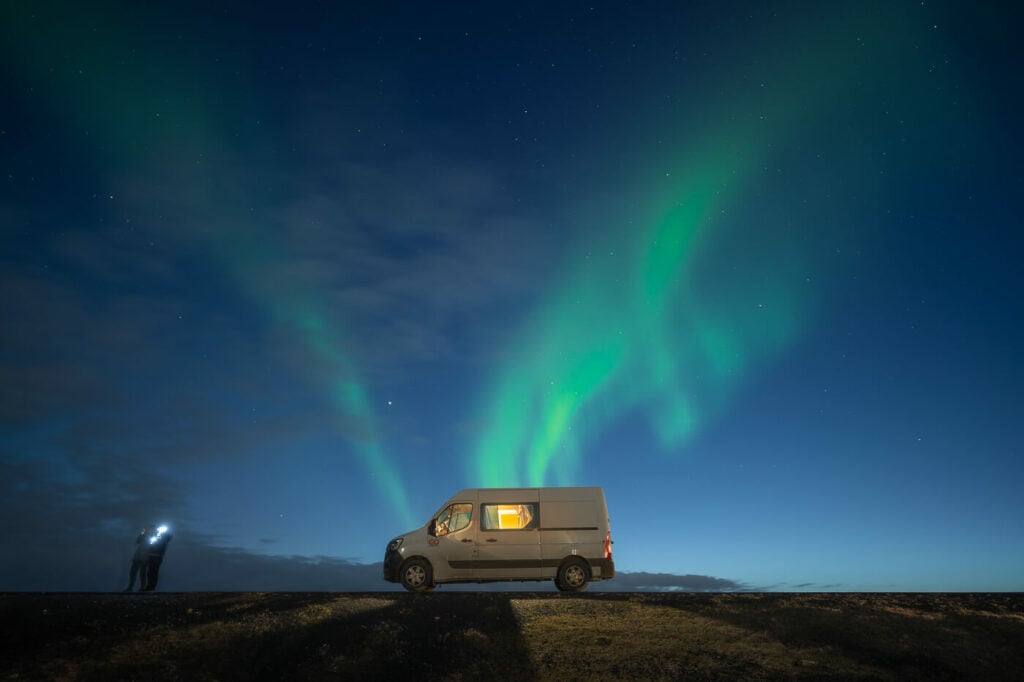
Parked Van under the northern lights right across from Seljalandsfoss.
Where to stay
There are no hotels near Seljalandsfoss, but there are several guesthouses, glamping or farm accommodation options. In high season, and especially in July and August, you should book accommodation well in advance, if you are planning to spend the night here.
Also, there is a campsite near Seljalandsfoss, the Hamragarðar campsite right under
It’s suitable for Campers, Vans, and tents. Basic facilities and toilets are available.
Additional Resources
Here are some resources to keep you exploring Iceland:
- Skogafoss is the next major waterfall going further south, and if you are looking for a longer, more challenging, and amazing hike with more waterfalls, check out the Waterfall Way behind Skogafoss!
- Discover more epic waterfall hikes in Iceland, like Dettifoss, Gullfoss, or Dynjandi.
- Check out more Hikes in Iceland (with maps) here.
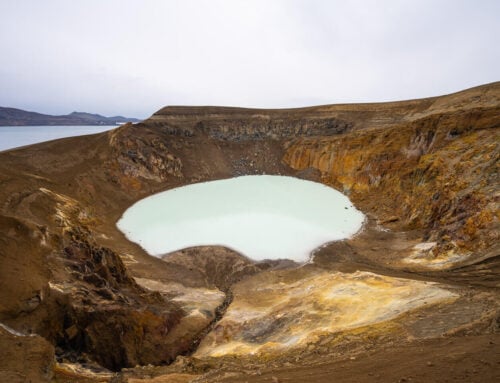
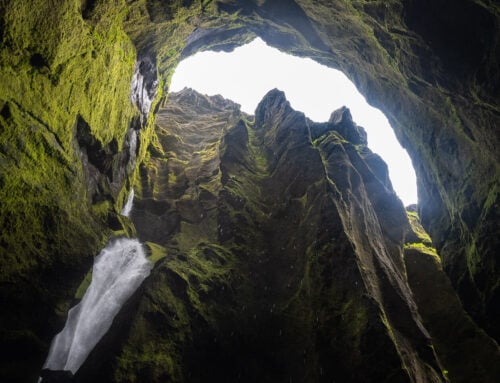
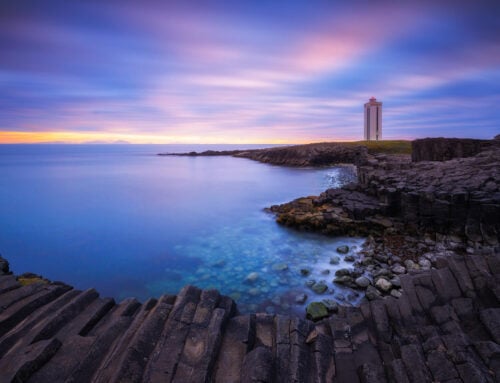

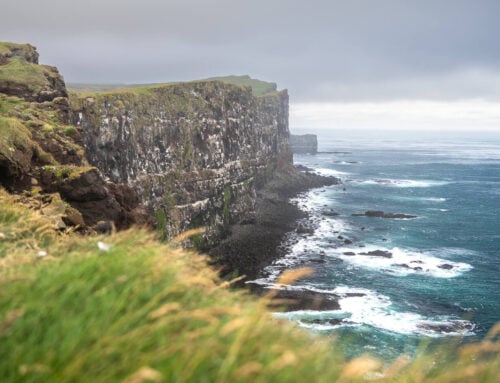

Leave A Comment